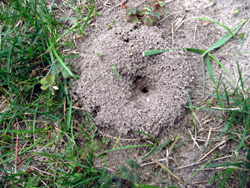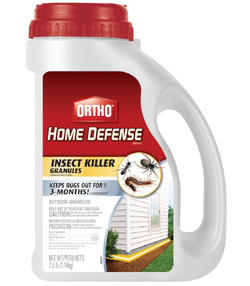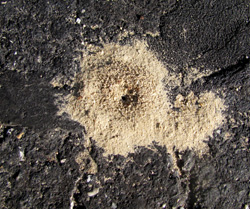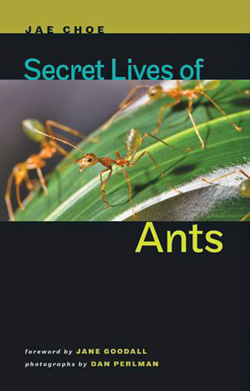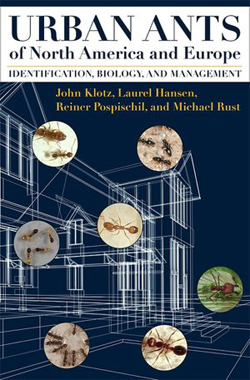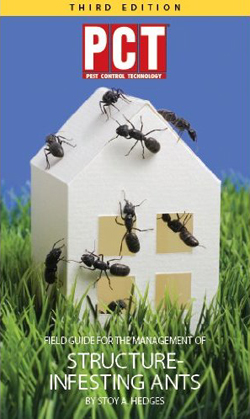
Ants and Ant Control
Ants
There are more than 12,000 known species of ants. They have colonized almost every landmass on earth. Most of them we may never see; only about a dozen are common pests. Ants known as household pests include odorous house ants, yellow crazy ants, pharaoh ants, sugar ants, grease ants, pavement ants, carpenter ants and argentine ants.
Ants that can be pests around a household can be grouped into three categories. These are house-infesting ants, yard-infesting ants and carpenter ants.
House-Invasive Ants
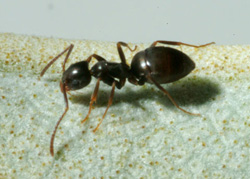
Odorous House Ant
Image Credit - UCI
House-Invasive ants are the ones you might see crawling along your kitchen counter. They include odorous house ants, crazy ants, pharaoh ants, sugar ants and grease ants. Oderous ants get their name from the strong rotten coconut-like smell they give off when crushed.
Besides being unsightly, these ants can get into, and contaminate household food. Ants are attracted to food items that may be only crumbs or even just a tiny spill. They are especially attracted to sugars, syrups, jam, honey, and fruit juice along with greases and fats. They are very clever at being able to get into containers that are not tightly sealed.
Most ants you see are "scout" ants or "worker" ants. They don't directly eat the foodstuffs they find, but take it back to their nests where it is fed to a Queen, juvenile ants, and other worker ants. This behavior provides the key for getting rid of the ants.
Control of Ants
If you kill an ant that you see, you only kill that one ant. However, there are probably hundreds, or possibly even thousands more that you don't see. If you can get them to take some poisoned food items back to their nest you will kill many, most, or even possibly all of the ants, including the Queen. That wipes out the entire colony, and that is your goal.
Ant Traps
The best approach is to use an ant trap that is a bait holder, or bait station, containing a bait laced with a slow-acting poison. This way the poisoned bait can be taken back to the ants nest and be eventually ingested by the whole colony; killing them all.
We have been successful using this approach for years. Using a mixture of borax mixed in with regular table sugar as an ant bait has successfully defeated our indoor ant attacks. Another good mix is powdered borax and honey. You can mix it well and make a paste with a popsicle stick.
Since some ants are "grease" ants and not "sugar" ants, we also mix some borax with bacon grease and put that in another a bait station. If we are not sure which the ants will go for, we put both in one bait station; one tiny batch on each side of the station. The mixture we use is about 1 part borax to 4 to 6 parts sugar, honey or grease. If you make it too rich with borax, you will see ants dying on the spot without taking the mix back to their nest, which is the goal. Be aware that you don't have to FILL the entire cap with the mixture. Just put a small dot of about a quarter to a third of an inch. Ants are very small. They individually take back very tiny amounts. You don't need much!
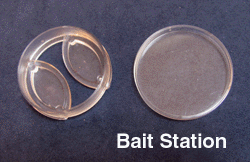
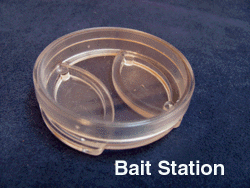
You can buy small containers with lids that are clear that have a tiny hole for ants to enter and exit without having the mix open to the air or accessible to whoever or whatever walks by. (We have purchased these small clear bait stations upon occasion from the Gardens Alive company). We mount these on windowsills where ants have come in by securing the underneath with a tiny bits of poster/picture tack that is like sticky putty. It will come off without ruining anything when you are ready to take your bait stations down. But it is strong enough to hold everything together for as-long-as you have your bait stations up. Locate the bait as near to the ant trail as possible.
Instead of purchasing ant bait holders or bait stations, we often make our own by using the cap from a milk or juice bottle glued upside down with the same poster/picture putty, close to the ant trail. Then we put a laundry detergent, or fabric softener top or some other domed lid that covers the cap containing the mixture. The domed lid has to have a tiny area for the ants to enter and exit cut out of the bottom before you mount it over the cap. Just a very small hole will do since ants can enter extremely small spaces. We mount that with tiny bits of putty over the cap to protect it and keep it from being tampered with by anything other than the ants for which it is intended. It also protects the bait from rain coming through the window screen. The home-made version works just as well as the purchased version and is made from items usually found in the home. (And they are free).
Follow this link to see more about Homemade Ant Traps
These ant bait stations, whether purchased or homemade, can be secured to a window between the screen and the inside sash. We secure them in a corner and they stay there for the entire season despite rainy weather. We leave them up where ants have been seen and the problem takes care of itself.
Please be aware that this mixture is toxic to humans and pets also. Borax IS a poison. You don't want toxic baits available for animals or children to handle or contact or ingest. And wash your hands after handling borax.
Now the hard part comes in. You have to LET the ants come and go without hindrance. The first instinct is to kill them as they come in. That defeats the purpose. You might have several come, or even hundreds. But you have to let them take the bait back to the nest. Within two or three days there will be no ants. Then you know it has worked. You won!
"Once you get rid of them you have to keep others from coming. This requires careful attention to sanitation and cleanliness. If they have no access to food items they won't be there. Keep all food items sealed. Don't leave partially opened boxes of food in the pantry. Quickly wipe up spills and sweep up dropped crumbs," so say the experts. We wonder if they have ever even HAD an ant problem. In actuality, it is almost impossible to find and wipe up every spilled drip. Ants will find drips you can't even see. They will come into your bathroom for toothpaste on your toothbrush! We find that these ant traps placed strategically around the home under cabinets, in the back of sink cabinets, on windowsills and the like have stopped the problem for us. We hope we have helped you get control of them in your home, too.
Yard-Invasive Ants
Yard-Invasive ants are those you see in the lawn that make those ugly mounds. They also include the pavement ant that makes its home in the cracks in pavements and driveways. These ants feed on almost anything, including other insects, meats, cheese, nuts, seeds, bread and sweets.
These ants make their nests underground and they make mounds at the entrance with their excavations. The mounds give away the locations of their nests.
The inaccessibility of the deeper parts of their nests makes it difficult to eradicate them. You can kill the ones you see but many more are underground. Such ant colonies are also very adaptive, so eliminating the entire colony is nearly impossible. Most attempts at control are temporary solutions.
Yard ants generally make their nests where grass is thin, or in bare spots. A heavy thick lawn discourages these ants, and they go elsewhere. Yard ants can be a pain, but they can also be beneficial. They eat aphids and other annoying insects, and they can airiate the soil.
We have always hesitated to use baits for outdoor ants because pets and other wildlife might find the baits and be harmed.
However the following technique is safer and has worked for us: Poke a screwdriver down the ant hole and twist it around, making a small shaft into the ground. Pour Insect Killer Granules down the hole, then cover it over with dirt and pack it down. The next time it rains, the rain will dissolve some of the poison granules and flood the ant tunnels. This will kill the ants. Do this to each, or most of the holes you find. Soon you will have no more, or at least less yard ants.
We have used Ortho Home Defense Insect Killer Granules, and they work well. These are available from Amazon.com.
Ants in Driveway Cracks
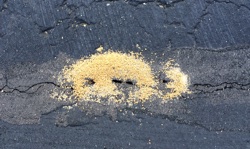
Driveway Ants
Pavement ants in asphalt driveways can be a serious problem. They build their nest by excavating under the driveway. You can see entrances to their nests along driveway cracks, where they bring up grains of sand and dirt and form mounds around the entrance holes. If they excavate too much of the underlying earth, voids form under the driveway which can eventually cave in where the stabilizing bed of soil underneath has been removed.
The best way to solve the ant in the asphalt driveway problem, is to fill the cracks. Use a screwdriver to scratch out the loose dirt and stones in the crack, then brush the cracks clean. Using a putty knife, fill the cracks with asphalt driveway patch. That should do it.
Carpenter Ants
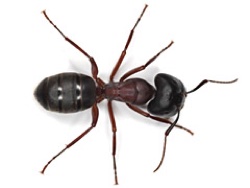
Carpenter Ant
Carpenter ants are one of the largest ants, ranging from ¾ to ½ inch in length. They can become pests when they choose to build a nest in your dwelling.
Carpenter ants typically nest outdoors in rotting stumps, logs, firewood stacks, fence posts and damaged trees. However, these ants will forage as much as 100 yards from their nests and often invade homes in search of food and water and a better home...yours.
Carpenter ants don't consume wood like termites, but excavate wood to make their nests. The nests can become extensive networks of galleries and tunnels as an ant colony grows in size. Then some serious damage may result as the wood in your home become tunnel ridden and structurally unsound.
To eliminate carpenter ants you first have to accurately locate their nest. You can do this by following them and identifying trails back to their nests.
We once had carpenter ants in a house we used to own. They were in a wall underneath a kitchen window. You could actually hear them chewing on the wood. There were shingles on the garage roof by the front door where ants appeared every spring. Lifting a shingle revealed a small spot where the wood had been tunneled out by the ants in years past (before we owned the home). We put the same honey/sugar/bacon grease/borax mix right on the trails with a kitchen table knife. The ants were gone within 24 hours. It became our spring ritual along with window cleaning. Where you see ants, you can try what we used.
If you still see ants and it is a larger job than you first thought, you can call a professional in to take care of them before they can do much damage to what is probably your largest investment: your home. Keep them at bay. Look for them regularly along with other pests, especially termites, they are worse than ants.
Aesop Fable Ants
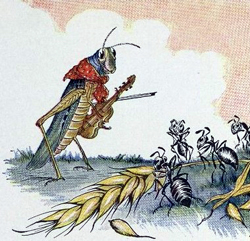
Ants have often been used in fables and children's stories to represent industriousness and cooperative effort. An example is the Aesop Fable "The Ant and the Grasshopper." An illustration from this fable is shown at the right.
Books About Ants and How to Control Them
Secret Lives of Ants
- by Jae Choe - 2012
Easily one of the most important animals on earth, ants seem to mirror the actions, emotions, and industries of the human population, often more effectively than humans do themselves. They developed ranching and farming long before humans, and their division of labor resembles the assembly lines of automobile factories and multi-national enterprises. Self-sacrifice and a finely tuned chemical language are the foundations of their monarchical society, which is capable of waging large-scale warfare and taking slaves. Tales of their massacres and atrocities, as well as struggles for power, are all too reminiscent of our own. The reality of ant society is more fascinating than even the most creative minds could imagine. Choe combines expert scientific knowledge with a real passion for these miniscule marvels. His vivid descriptions are paired with captivating illustrations and photographs to introduce readers to the economics, culture, and intrigue of the ant world. All of nature is revealed through the secret lives of the amazing ants. In the words of the author, "Once you get to know them, you will love them."
Urban Ants of North America and Europe - by John Klotz - 2008
Ants that commonly invade homes, damage structures, inflict painful bites, or sting humans or their pets are considered pest ants. This illustrated identification guide highlights forty species of ants that pose difficulties in urban settings. Included are well-known invasive troublemakers such as the red imported fire ant and Argentine ant, as well as native species. After an introductory chapter on the evolution, biology, and ecology of pest ants, the book follows a taxonomic arrangement by subfamily. Each subfamily chapter includes separate illustrated keys to both the genera and species of that group to enable entomologists and pest control professionals to identify pest ants correctly. The species accounts cover biology, distribution, and methods for excluding and/or removing ants from human structures and landscapes. The authors focus on the ants' biology and nesting behavior, life cycles, and feeding preferences; an intimate understanding of these factors enables the implementation of the least toxic control methods available. A chapter on control principles and techniques encompasses chemical strategies, habitat and structural modifications, biological control, and integrated pest management methods. Urban Ants of North America and Europe also contains valuable information on the diagnosis and treatment of human reactions to ant stings and bites. This comprehensive reference work on these economically significant ants includes the scientific, English, French, Spanish, and German names for each species and a summary of invasive ant species in the United States and Europe.
PCT Field Guide For The Management of Structure Infesting Ants - by Stoy A. Hedges - 1998
The Ant Field Guide is an essential educational resource for pest management professionals. This handbook was written to provide pest management professionals with a handy resource they can access from their service vehicles for practical, up-to-date information on these challenging pests. Topics covered include: Basic Ant Biology, Inspection Tips, Successful Treatment Strategies, Instant Ant Identification, Taxonomic Keys, Full-Color Photo ID Section and Emerging Ant Species.
